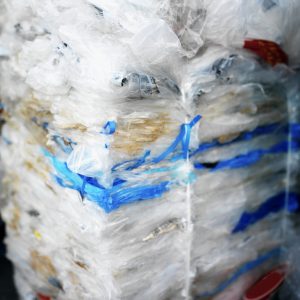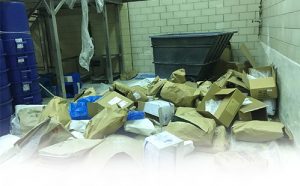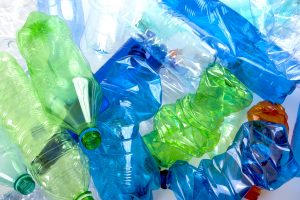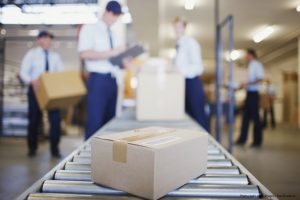by CharlieB | Jun 28, 2017
 Water is wonderful. After all, we wouldn’t be able to live without it! But there are some places that we just don’t want to see water. Nobody’s happy to stumble upon a flooded basement, for example. Nor is it desirable to see enormous puddles in the yard. And of course, nobody wants to deal with excess water in their waste! Many manufacturers utilize dewatering equipment in order to keep their waste dry and easy to manage. But there are many other great reasons to do it that you may not know about! Here are 5 hidden benefits to employing more dewatering equipment in your waste management process.
Water is wonderful. After all, we wouldn’t be able to live without it! But there are some places that we just don’t want to see water. Nobody’s happy to stumble upon a flooded basement, for example. Nor is it desirable to see enormous puddles in the yard. And of course, nobody wants to deal with excess water in their waste! Many manufacturers utilize dewatering equipment in order to keep their waste dry and easy to manage. But there are many other great reasons to do it that you may not know about! Here are 5 hidden benefits to employing more dewatering equipment in your waste management process.
For questions about dewatering equipment or anything else to do with your waste compactor, turn to KenBay. We are an experienced company dedicated to proper waste management. Our goal is to lead companies to follow a zero landfill initiative through easy, efficient waste compactors. If you want to know more about KenBay and our zero landfill initiative, visit our website.
Why You Should Use Dewatering Equipment
Ability to Recycle More
At KenBay, we like to talk a lot about reducing the amount of “air” put onto the truck. Well guess what? Water works the same way. The more water is held inside of your waste, the less waste you’re able to fit onto the truck. Use dewatering equipment to save space, allowing you to recycle more when you need to. And you save money as well!
Less Trash to Landfill
One of the great things about dewatering is that it opens the door for opportunities to recycle. When waste is dewatered, it is transformed into a dry filter cake. Usually, that cake makes the waste easier to transport and dispose of. But when the cake is non-toxic, it can also be reused for other purposes. Thus, less trash gets sent off to the landfill overall.
Ability to Separate Plastic Cap From Cardboard Container
Plastic and cardboard can work well together, but they’re not the easiest to get rid of. They must be separated first, and recycled separately. Dewatering equipment can handle it easily!
Don’t Pay to Ship Remnant Ingredients
Little bits of leftovers can get annoying. They’re too small to do anything with, but it’s not worth paying to ship them or dispose of them. Dewatering equipment makes it so you won’t have to worry about that problem anymore!
Cleaner Plant Environment
A clean environment is a safe environment. And having wet, nasty waste everywhere definitely does not make for a clean environment. Turn to dewatering equipment to destroy the sludge, keep things dry, and make your workers happy!
KenBay Can Dewater . . . and So Much More
For dewatering applications the SC 2000 and SC 3000 Screw Compactors provide continuous throughput and are configured for de-packaging/de-watering or for foam densifying. These screw compactors can be an integral part of a system that will make your facility landfill free. The SC 2000/3000 is a low maintenance heavy-duty piece of equipment capable of handling large throughputs of material while still maintaining a high compaction rate continuously throughout the operation.
The output from them is ready for delivery to a Waste-To-Energy (WTE) facility having extracted whatever liquids they contain. The Screw Compactors perform well for de-packaging:
- milk
- yogurt
- soft drinks
- BBQ Sauces and ketchups
- ice cream
- liquid soaps and detergents
- and much more
To learn more go to “SC 2000 & 3000 Screw Compactors”
by CharlieB | Jun 22, 2017
 Do you ever think about your compaction rate? Probably not. People don’t usually give much thought to handling waste. Most people just toss their waste away, and forget about it. But when it comes to using a waste compactor, it’s important to know your compaction rate. Obviously you want a better compaction rate in order to handle the waste quickly. But are there other benefits as well? Believe it or not, your compaction rate also affects your wallet. A higher one leads to better savings. A lower one could mean wasting more money than you meant to. Here’s what you need to know about saving money with your waste compactor.
Do you ever think about your compaction rate? Probably not. People don’t usually give much thought to handling waste. Most people just toss their waste away, and forget about it. But when it comes to using a waste compactor, it’s important to know your compaction rate. Obviously you want a better compaction rate in order to handle the waste quickly. But are there other benefits as well? Believe it or not, your compaction rate also affects your wallet. A higher one leads to better savings. A lower one could mean wasting more money than you meant to. Here’s what you need to know about saving money with your waste compactor.
For questions about compaction rate or anything else to do with your waste compactor, turn to KenBay. We are an experienced company dedicated to proper waste management. Our goal is to lead companies to follow a zero landfill initiative through easy, efficient waste compactors. If you want to know more about KenBay and our zero landfill initiative, visit our website.
How a Better Compaction Rate Leads to Cost Savings
Fewer Bags
It’s simple math: the more bags you use, the more money you spend purchasing replacement bags. Some compactors are so inefficient that you need to change out the bags far too frequently. Others cannot handle plastic waste very well. Plastic waste tends to retain its original shape, and resists compacting. But with the right compactor, none of this is a problem. You should simply toss it in and forget about it.
Don’t Ship “Air”
Another side effect of a lower compaction rate is that you end up shipping “air.” If you can’t compact your waste fully, then you’re filling the truck with empty space. It’s would be like if you simply hired a truck to transport only air to another location. A good compactor makes it so that you fill the truck with only waste. That way, you won’t require as many deliveries, and continue to save money!
Less Swapping Out of Bags, Less Foot Traffic
Of course if you are swapping out your bags less often, that means you won’t need to spend productive time moving bags off the plant floor. You also won’t need to spend time moving them around or across the plant floor. In addition to improving overall safety, you will save time because your people can be more productive! They’ll be able to get back to the tasks that really matter, instead of “wasting” it on waste.
Turn to KenBay for a Better Compactor
There’s a lot of compactor options out there. It may be tempting to think that bigger is better. But buying a large bulky compactor is no guarantee of power. Instead, why not try one of KenBay’s RotoPacs? The RotoPac is portable, so you can transport it easily across the floor to wherever you need. Put it right at the source of your waste for maximum effect. And you can bet that the RotoPac has a fantastic compaction rate! If you want to try out a RotoPac for yourself, visit our website to try one out for yourself. You’ll be impressed at it’s power . . . and your savings!
by timm | Jun 13, 2017
 Bakeries, ingredient processing companies, the granary and feed industry, among many other high and medium volume industries receive content in 50 lbs. bags. The bags are generally made of paper lined or reinforced with plastic. Problems these emptied bags create are the following
Bakeries, ingredient processing companies, the granary and feed industry, among many other high and medium volume industries receive content in 50 lbs. bags. The bags are generally made of paper lined or reinforced with plastic. Problems these emptied bags create are the following
- They are made of mixed materials, i.e., plastic and paper make them unfeasible to easily and properly recycle.
- Large volumes of bags require wasted hours of physical labor & forklifts to transport bags to waste compactor, especially to stationary compactors or dumpsters.
- Getting the bags transported and compacted to reduce hauling costs can be somewhat labor intensive.
The factors affecting the disposing of these 50 lbs. bags are that the bags need to be greatly compacted and it is highly desirable that it be done where the bags are emptied.
Compacting Bags Where They are Emptied
- The person handling the bags can throw the empty bags into the compactor located at the waste’s source without moving after emptying its content into a mixer or another machine. He/she will be the last person touching the bags in the disposal process. If a machine is used to open and empty the bags it can deposit the bags directly into the compactor. The compacting process is best accomplished with the use of a continuous compactor rather than a type of baler.
Dealing with the Dust
- Frequently the residue left in the bags creates a great deal of dust, especially in some instances near where food is being processed. A dust collector can be utilized to remove the dust from the environment from the chute in which the bags are thrown passing to an enclosed chamber compactor. Or dust collection can be done from the enclosed chamber. Compacting 50 lbss. bags into large plastic bags that can be sealed for transport also reduces ambient dust.
Reducing Labor & Hauling Costs:
- Costs are reduced with fewer trips either using a pallet jack or a forklift to remove the waste filled bag from the compactor to the hauler’s container outside. The waste filled bags contain approximately 800 50 lbs. bags. Contrast this to frequent trips hauling between 100 and 200 bags loosely placed on a pallet being hauled by forklift. Reducing forklift traffic on a factory floor is always a good thing in a number of ways, such as, safety, maintenance and cost reduction.
- One meter cubes of plastic filled waste are easily manageable for transporting either in a dumpster to landfill or in a covered trailer with double stacked bags to a Waste to Energy facility. Reducing the cost of transport of waste is critical to profitability in all types of waste disposal whether it be to landfill, recycling or Waste to Energy (WtE) facilities.
KenBay has been helping many companies in a variety of industries reduce labor and hauling costs of those ubiquitous 50 lbs. bags using the original industrial rotary arm compactor, the RotoPac. Why not go to the front page of www.kenbay.com and see the RotoPac in operation? If you would like to try out a KenBay RotoPac for yourself, you can try one before you buy one. Simply pay a small fee and we’ll send one to your location. After all, you have nothing to lose but costs.
by CharlieB | Jun 12, 2017
 Plastic revolutionized our way of life. Businesses and manufacturers applied plastic to nearly every industry imaginable. The lightness of and durability of plastic improved our packaging, our construction, and how we develop new technology. And it seems like plastic use is only heading upwards. But one downside is that not enough people recycle the plastic that they use. Major manufacturing plants in particular are hesitant to deliver their plastics to a recycling station. Many of them fear that the cost of transport may is too oppressive. But fortunately, there is a workaround. If you’re worried about the cost of your plastics, here’s how to efficiently deliver them to the recycling station.
Plastic revolutionized our way of life. Businesses and manufacturers applied plastic to nearly every industry imaginable. The lightness of and durability of plastic improved our packaging, our construction, and how we develop new technology. And it seems like plastic use is only heading upwards. But one downside is that not enough people recycle the plastic that they use. Major manufacturing plants in particular are hesitant to deliver their plastics to a recycling station. Many of them fear that the cost of transport may is too oppressive. But fortunately, there is a workaround. If you’re worried about the cost of your plastics, here’s how to efficiently deliver them to the recycling station.
Whether it’s helping transport plastic to the recycling station or giving other great tips, KenBay is committed to zero waste. We offer a wide range of compactors to you for plastic and other kinds of waste. For more information, visit our website.
Off to the Recycling Station . . . But How?
The Problem with Transport
The biggest concern among manufacturers is the cost of transporting plastics. Plastic tends to expand, and doesn’t like bending from its original shape. That expansion means filling up more space on the freight truck, which then leads to a greater number of trips. Trips that you pay for, every time. Many companies attempt to cut down on these trips through compacting their plastic waste. But there’s still a problem with using something like a baler.
The Problems With Balers
Plastic wrap tends to “bounce back” or regain some of its original shape, even during a compaction process. Most balers don’t have the ability to continuously compact the waste without resorting to additional specialized equipment. They also can’t compact the plastic quickly enough to stifle the bounce back effect. As a result, the baler fills too quickly and compacts a smaller amount of plastic.
What’s the Better Solution?
The best solution is to forget using the baler and instead rely on a dependable compactor. Ideally, a compactor should feature a quick continuously rotating arm. Thus, the machine presses the plastic down so quickly and frequently it won’t have time to bounce back. Adding some heat will also help the process. Once you compact the plastic, store it inside an easily stackable bag. Now, more bags fit onto the truck, which means fewer overall trips to the recycling station. That’s where the savings come from!
KenBay Helps Your Plastics Get There
Plastics will play a major role in our effort towards renewable energy, but not if we don’t recycle them properly. One of the best ways to recycle your plastic is through our RotoPacs. RotoPacs not only are safe, easy, and offer continuous compaction, they deliver even more! They’re portable and very easy to move around your facility. You can put them right at the source of your plastic waste. That way, you reduce clutter and improve overall safety even further. If you would like to try out a KenBay RotoPac for yourself, you can try one before you buy one. Simply pay a small fee and we’ll send one to your location. Best of all, there’s no complicated process if you want to keep it for life. Simply pay the rest of the full price, and it’s yours!
by CharlieB | Jun 10, 2017
 Balers are popular, no doubt about that. Every year, companies wrestle with the decision over whether to purchase one. Do the benefits outweigh the expenses? How much money can you really save? These are just a few of the questions that companies ask themselves. But what many of them might not think of is that there is another option: a cardboard compactor. While not as well-known, cardboard compactors offer numerous advantages over traditional balers. Here are three ways that they are superior to the competition.
Balers are popular, no doubt about that. Every year, companies wrestle with the decision over whether to purchase one. Do the benefits outweigh the expenses? How much money can you really save? These are just a few of the questions that companies ask themselves. But what many of them might not think of is that there is another option: a cardboard compactor. While not as well-known, cardboard compactors offer numerous advantages over traditional balers. Here are three ways that they are superior to the competition.
Whether it’s using a cardboard compactor or promoting the value of zero waste, KenBay is committed to recycling. We offer a wide range of compactors to you. For more information, visit our website.
3 Ways a Cardboard Compactor is Superior to a Baler
Continuous Compaction
One problem with using a baler is the need for continuous compaction. Most standard balers do not provide the option for continuous compaction. In order to get it, you need to order additional specialized equipment or attachments. This costs additional expenses that you probably want to avoid. Also, if the specialized equipment breaks, you need to spend even more money to repair or replace it. Continuous compaction is better because your waste is better reduced, and it’s easier to transport.
A Cardboard Compactor Requires No Special Skills
Another problem with a baler is that it requires a specialist to use. Many balers do not fully compact plastic. They create stages of the plastic. Then, a specialist on standby needs to bale the plastic manually and insert bale ties to remove it. This is much more time consuming and inconvenient. A much better option is to let the machine do all the work. A cardboard compactor continuously rotates the plastic into place, and then it’s easy to remove by anyone.
A Cardboard Compactor is Safer Than a Baler
Think about this also: when balers require specialists to handle, there’s a greater chance that someone is hurt. Generally, when a process involves more people, it is riskier. A cardboard compactor is better requires minimal labor because it doesn’t need specialized training. Additionally, some companies only allow for union workers to handle balers. A cardboard compactor is so easy to use that anyone can do it! Safety should be a paramount reason for companies to make decisions like this. And in this case, the ease and automation clearly put cardboard compactors on top.
Choose a KenBay RotoPac for Your Cardboard Compactor
KenBay offers a fantastic cardboard compactor to you through our RotoPacs. RotoPacs not only are safe, easy and offer continuous compaction, they offer even more! They’re portable and very easy to move around your facility. You can put them right at the source of your waste, reducing clutter and improving overall safety even further. If you would like to try out a KenBay RotoPac for yourself, you can try one before you buy one. Simply pay a small fee and we’ll send one to your location. Best of all, there’s no complicated process if you want to keep it for life. Simply pay the rest of the full price, and it’s yours!
by CharlieB | Jun 4, 2017
 What is waste management costing you? Many of you might think that it doesn’t take that much money. But waste management is a surprisingly large sinkhole which your cash will disappear into. The cost of the waste management is not the key element in this expensive equation. Rather, the small hidden costs which build up over time. These include maintenance, labor, and the materials themselves. The Ohio EPA breaks down the surprising costs of waste management. For some manufacturers, their expenses got so high they tripled the expected cost! So, what can you do? Well, there’s a few things experts (ourselves included) recommend you do to make sure you know what you’re actually paying. And there’s a few more things you can do to pay less!
What is waste management costing you? Many of you might think that it doesn’t take that much money. But waste management is a surprisingly large sinkhole which your cash will disappear into. The cost of the waste management is not the key element in this expensive equation. Rather, the small hidden costs which build up over time. These include maintenance, labor, and the materials themselves. The Ohio EPA breaks down the surprising costs of waste management. For some manufacturers, their expenses got so high they tripled the expected cost! So, what can you do? Well, there’s a few things experts (ourselves included) recommend you do to make sure you know what you’re actually paying. And there’s a few more things you can do to pay less!
For more great tips on recycling and waste management, rely on KenBay. We manufacture portable waste compactors for manufacturers and plants. We’re also committed to a zero waste initiative, and encourage other companies and corporations to follow suit!
What is Waste Management’s Hidden Fees?
It’s important to remember that waste management does not exist in a vacuum. Purchase of raw material is absolutely a factor in overall cost. As is maintenance and upkeep of that material once you have implemented it. Replacement parts also add to your overall costs. And we can’t forget the labor! You will require someone to install the raw material, someone else to replace parts, and someone else to (eventually) haul it all away. Bring those all together and it’s no wonder that waste management costs as much as it does!
So What Can You Do About It?
The first and most important thing you can do is be aware of your processes. This advice is not just for waste management, it’s makes for an overall more efficient plant. Be aware where your material comes from, how much is needed, and where it ends up. You are likely to end up discovering some wasted money. For example, you could discover that your company is spending extra on one certain raw material that it must then discard. Once you know these blind spots, work to correct them and minimize the loss of money.
Secondly, don’t be afraid to turn to secondary resources. The Environmental Protection Agency has great advice on waste management (such as the article linked above). KenBay also regularly provides advice through this blog.
As far as the waste disposal process goes, every little bit counts. One great way to save money is to use the right kind of compactor. KenBay’s RotoPacs save you money through creating efficiency and eliminating unnecessary functions. RotoPacs are portable, so they cut out some need for additional disposal labor. Simply throw the waste away at the source! Additionally, RotoPacs compact your waste efficiently into cube shapes. You can stack the waste cubes easily onto the truck, and therefore need fewer trips overall. If you want to try out a KenBay RotoPac for yourself, you can try one before you buy it. If you like the RotoPac, simply pay the difference to keep it there. Stay on top of your waste and your processes, and you may never need to ask yourself: “What is waste management really costing me?”
 Water is wonderful. After all, we wouldn’t be able to live without it! But there are some places that we just don’t want to see water. Nobody’s happy to stumble upon a flooded basement, for example. Nor is it desirable to see enormous puddles in the yard. And of course, nobody wants to deal with excess water in their waste! Many manufacturers utilize dewatering equipment in order to keep their waste dry and easy to manage. But there are many other great reasons to do it that you may not know about! Here are 5 hidden benefits to employing more dewatering equipment in your waste management process.
Water is wonderful. After all, we wouldn’t be able to live without it! But there are some places that we just don’t want to see water. Nobody’s happy to stumble upon a flooded basement, for example. Nor is it desirable to see enormous puddles in the yard. And of course, nobody wants to deal with excess water in their waste! Many manufacturers utilize dewatering equipment in order to keep their waste dry and easy to manage. But there are many other great reasons to do it that you may not know about! Here are 5 hidden benefits to employing more dewatering equipment in your waste management process.

 Do you ever think about your compaction rate? Probably not. People don’t usually give much thought to handling waste. Most people just toss their waste away, and forget about it. But when it comes to using a waste compactor, it’s important to know your compaction rate. Obviously you want a better compaction rate in order to handle the waste quickly. But are there other benefits as well? Believe it or not, your compaction rate also affects your wallet. A higher one leads to better savings. A lower one could mean wasting more money than you meant to. Here’s what you need to know about saving money with your waste compactor.
Do you ever think about your compaction rate? Probably not. People don’t usually give much thought to handling waste. Most people just toss their waste away, and forget about it. But when it comes to using a waste compactor, it’s important to know your compaction rate. Obviously you want a better compaction rate in order to handle the waste quickly. But are there other benefits as well? Believe it or not, your compaction rate also affects your wallet. A higher one leads to better savings. A lower one could mean wasting more money than you meant to. Here’s what you need to know about saving money with your waste compactor. Bakeries, ingredient processing companies, the granary and feed industry, among many other high and medium volume industries receive content in 50 lbs. bags. The bags are generally made of paper lined or reinforced with
Bakeries, ingredient processing companies, the granary and feed industry, among many other high and medium volume industries receive content in 50 lbs. bags. The bags are generally made of paper lined or reinforced with  Plastic revolutionized our way of life. Businesses and manufacturers applied plastic to nearly every industry imaginable. The lightness of and durability of plastic
Plastic revolutionized our way of life. Businesses and manufacturers applied plastic to nearly every industry imaginable. The lightness of and durability of plastic  Balers are popular, no doubt about that. Every year,
Balers are popular, no doubt about that. Every year,  What is waste management costing you? Many of you might think that it doesn’t take that much money. But waste management is a surprisingly large sinkhole which your cash will disappear into. The cost of the waste management is not the key element in this expensive equation. Rather, the small hidden costs which build up over time. These include maintenance, labor, and the materials themselves. The Ohio EPA
What is waste management costing you? Many of you might think that it doesn’t take that much money. But waste management is a surprisingly large sinkhole which your cash will disappear into. The cost of the waste management is not the key element in this expensive equation. Rather, the small hidden costs which build up over time. These include maintenance, labor, and the materials themselves. The Ohio EPA